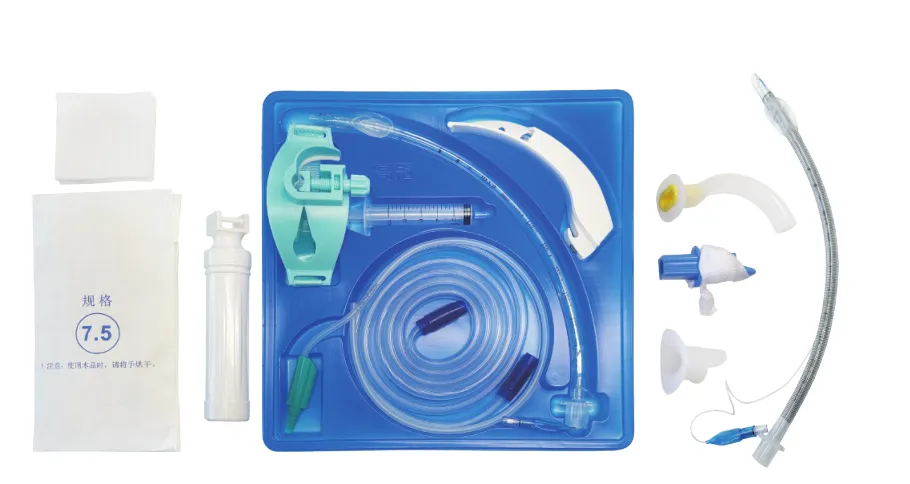Essential Scenarios Requiring an Endotracheal Tube Kit
In this section, I will discuss key medical scenarios where an endotracheal tube kit plays an indispensable role in patient care. These are situations where airway management is critical, and the availability of an endotracheal tube kit can significantly impact survival and recovery outcomes.
Cardiac Arrest and Cardiopulmonary Resuscitation (CPR)
When someone goes into cardiac arrest, managing their airway becomes absolutely essential if we want to bring them back successfully, which means having an endotracheal tube kit ready at all times makes perfect sense in emergencies. Time matters a lot here - every second counts when trying to save lives. Research indicates that getting the tube placed during CPR actually leads to better results overall. The American Heart Association recommends that only qualified personnel perform these advanced airway procedures because they require specific skills to do right. A good quality kit in the hands of trained staff lets medical teams get those critical airway controls established quickly, something that literally keeps patients alive while waiting for other interventions during resuscitation efforts.
Acute Respiratory Failure Requiring Mechanical Ventilation
When someone experiences acute respiratory failure, quick action is absolutely essential to stop them from getting dangerously low on oxygen. That's where having an endotracheal tube kit handy makes all the difference between life and death situations. Studies show that getting the airway stabilized fast through mechanical ventilation really does make a significant impact on how well patients recover, particularly in intensive care units where every second counts. Things such as bad cases of pneumonia or conditions like ARDS (Acute Respiratory Distress Syndrome) tend to worsen existing breathing problems, which means doctors absolutely must have those specialized airway management tools at their fingertips. Just having access to these kits allows medical staff to start up mechanical ventilation when needed, helping maintain proper breathing function while keeping oxygen levels stable in critically ill patients. Proper airway management isn't just about following protocols it's about being ready for whatever comes next in emergency situations where seconds matter most.
Surgical and Anesthetic Applications
General Anesthesia for High-Risk Procedures
When dealing with high risk surgeries, getting the airway secured through intubation becomes really important, which makes having an endotracheal tube kit absolutely necessary. According to the American Society of Anesthesiologists, picking the right method for managing someone's airway makes a big difference in how well surgery goes and keeps patients safe. These special tubes allow doctors to control breathing and deliver oxygen properly, something that matters a lot for people who already have lung problems or other issues affecting their ability to breathe. Proper intubation helps keep air flowing steadily throughout surgery, cutting down on all sorts of dangers that might otherwise happen.
Airway Management in Trauma or Burn Patients
Patients who have suffered trauma often need quick intubation if they've sustained facial or neck injuries to protect their airway properly. Research shows that getting an endotracheal tube placed promptly reduces risks like aspiration and low oxygen levels, problems that can kill someone badly hurt. For people burned over large areas of skin, especially when smoke has been inhaled, these tubes become absolutely essential equipment. Burn victims present unique challenges because their tissues swell so dramatically after injury. A good quality endotracheal tube kit makes all the difference in keeping those swollen airways clear during critical moments when even minor blockage could spell disaster.
Maintaining open and secure airways in trauma and burn patients requires precise and effective strategies, highlighting the endotracheal tube kit's vital role in critical care scenarios.
Critical Care and Prolonged Ventilation Needs
When dealing with serious flare-ups of COPD or asthma, stopping respiratory failure becomes a top priority for doctors. For patients in this situation, putting in an endotracheal tube and starting mechanical breathing support often makes all the difference according to what we see in emergency rooms across the country. Getting that tube placed early really helps people bounce back faster and increases their chances of making it through the worst of it. The breathing machine attached to the tube gives crucial help while the body fights off whatever triggered the attack, which means patients generally come out of these situations much better than they would without timely intervention.
Respiratory issues are a major concern when dealing with neuromuscular disorders. Patients suffering from conditions like Myasthenia Gravis or Guillain-Barré Syndrome often struggle to breathe properly, sometimes requiring immediate intubation just to stay alive. Studies show how crucial endotracheal tube kits become in emergency rooms and ICU units where patients need continuous ventilatory support. Managing these neurological conditions isn't something doctors handle alone. Nurses, therapists, and specialists all work together, highlighting why hospitals must keep those endotracheal kits within easy reach during complicated procedures. When multiple experts collaborate closely, they can address the many different ways these disorders affect breathing, ensuring patients get the right kind of help at exactly the right moment.

Pediatric and Neonatal Intubation Considerations
Premature Infants with Underdeveloped Airways
Babies born too early commonly struggle with intubation procedures since their airways just aren't developed enough yet, which means doctors need special methods adapted for these little ones. Research indicates that getting a neonatologist involved early on makes a real difference in how babies do after birth, especially when they have access to those specially made endotracheal tube kits. Getting the size right matters a lot here, so having different sized tubes ready goes a long way toward making things work out better for preemies. Hospitals that stock up properly on pediatric equipment give their staff what they need to handle these delicate situations effectively without unnecessary risks.
Pediatric Emergencies Requiring Secure Airway
When dealing with kids in medical emergencies, getting an endotracheal tube into place quickly can literally mean saving lives. Studies show that emergency rooms stocked with complete endotracheal kits tend to handle these cases better and faster. The right gear matters a lot too since children come in all shapes and sizes. Using tubes designed for specific age groups cuts down on problems that might happen during insertion. Clinicians who take this approach generally see fewer issues arise later on, which makes sense given how delicate pediatric patients are compared to adults.
Contraindications and Alternative Airway Solutions
When to Choose Supraglottic Airways Over Endotracheal Intubation
When dealing with unexpected tough cases where getting an endotracheal tube in place proves challenging, many clinicians opt for supraglottic airways instead to avoid making things worse. Research indicates that in situations involving blocked airways or patients who are hard to reach physically, these supraglottic devices tend to work better because they're easier to put in quickly. Most medical professionals will tell you that deciding whether to go with a supraglottic airway requires looking at both established protocols and their own experience level. How this choice gets made really matters for how patients fare overall, sometimes making all the difference between successful treatment and serious complications down the road.
Managing Difficult Airways or Anatomical Abnormalities
When dealing with difficult airways, anatomical issues are usually behind the problem, which means standard approaches won't work every time. Medical guidelines from various airway management groups all point to the same thing though they keep saying it differently basically advising doctors to look at other options if regular intubation just isn't going to cut it. That's where having those special endotracheal tube kits becomes so important. These kits give medical staff what they need right there at the bedside to handle tricky cases without panicking. Real world experience shows that when clinicians have access to these specialized tools, they can tailor their approach much better to each specific patient situation. This makes a huge difference in reducing complications and getting better outcomes overall, something everyone involved wants to see happen.
Verifying Proper Endotracheal Tube Placement
Using Capnography for Real-Time Confirmation
Capnography serves as a critical method to check where an endotracheal tube sits inside a patient's airway by looking at the carbon dioxide levels exhaled at the end of each breath. Research shows it actually cuts down on the chances of putting the tube in the wrong spot when someone gets intubated, which makes it better than just listening to breath sounds through a stethoscope. Most hospitals now include capnography as part of their routine protocols because it keeps patients safer during procedures. Doctors find that incorporating this technology leads to fewer problems overall and makes things run more smoothly in the clinical setting. Many practitioners consider it one of those must-have tools that define proper care standards for managing airways these days.
Assessing Clinical Signs of Successful Intubation
Looking at different clinical signs helps confirm whether an intubation was successful or not. When we check for equal breath sounds on both sides and watch for chest expansion, it gives us clues about where the tube actually sits inside the airway. But relying solely on one sign isn't enough because mistakes happen. Studies show that mixing several methods works better overall. That's why many medical teams now use standardized checklists during these procedures. These lists help everyone stay consistent in their assessments and ultimately keep patients safer during what can be a tricky process. Good assessment practices reduce potential problems down the road and give clinicians greater confidence when managing airways under pressure.
FAQ Section
What is an endotracheal tube kit used for?
An endotracheal tube kit is used for airway management in various critical medical scenarios, such as cardiac arrest, acute respiratory failure, trauma, burn conditions, and pediatric emergencies. The kit helps healthcare providers secure the airway during procedures requiring intubation.
Why is endotracheal intubation necessary during CPR?
Endotracheal intubation during CPR is necessary for effective airway management and to maximize the chances of survival. It helps ensure high-quality resuscitation by allowing healthcare providers to swiftly implement airway control techniques.
Which patients benefit the most from endotracheal intubation?
Patients suffering from acute respiratory failure, severe exacerbations of COPD or asthma, neuromuscular disorders, trauma, burns, and pediatric emergencies benefit the most from endotracheal intubation, as it provides necessary ventilatory support and oxygenation.
When should supraglottic airways be used instead of endotracheal tubes?
Supraglottic airways should be considered during difficult intubations, airway obstructions, or when limited patient access is encountered. These alternative methods prevent complications and offer a rapid solution.

